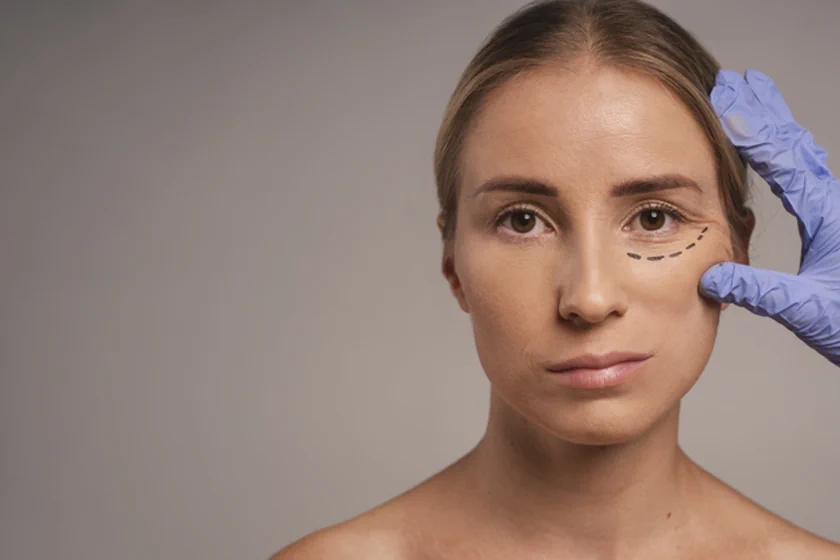|
Getting your Trinity Audio player ready...
|
Imagine waking up to a painful, swollen lump near your eye that seems to grow more uncomfortable with each passing hour. You might also notice redness, discharge, and excessive tearing. It sounds distressing, doesn’t it?
This could be a sign of dacryocystitis, an infection of the tear duct system. While it might sound alarming, understanding dacryocystitis and knowing how to treat it can make a significant difference in your recovery.
Let’s dive into everything you need to know about this condition.
What is Dacryocystitis?
Dacryocystitis is an infection of the lacrimal sac, the part of your tear duct system located near the inner corner of your eye.
This sac is responsible for draining tears from your eye into your nose. When this drainage system becomes blocked and infected, you develop dacryocystitis. It’s essentially a blockage in the tear duct, causing infection and inflammation.
What Are the Signs and Symptoms of Dacryocystitis?
Recognizing the symptoms of dacryocystitis early can help you get timely treatment and avoid complications. Common signs and symptoms include:
Redness and Swelling: The area near the inner corner of your eye may become red, swollen, and tender. The swelling can be significant enough to affect your daily activities.
Pain: The infected area can become quite painful, ranging from a dull ache to sharp, throbbing pain.
Discharge: You might notice a yellow or green discharge from the eye. This discharge can be particularly noticeable when you wake up in the morning.
Excessive Tearing: Since the tear duct is blocked, tears can overflow, leading to excessive tearing and a feeling of constant wetness.
Fever: In severe cases, a fever might accompany these symptoms, indicating that the infection is more serious.
What Causes Dacryocystitis?
Understanding the causes of dacryocystitis can help in both treatment and prevention. Here’s what you need to know:
Bacterial Infection: The most common cause of dacryocystitis is a bacterial infection. Bacteria such as Staphylococcus aureus and Streptococcus can infect the lacrimal sac, especially if there’s a blockage.
Congenital Blockage: In infants, dacryocystitis often results from a congenital blockage of the tear duct. This condition can cause tear duct obstruction from birth.
Chronic Conditions: Persistent sinusitis, allergies, or other conditions can lead to inflammation and blockages in the tear ducts.
Aging: As people age, their tear ducts can become less effective at draining tears, making them more susceptible to infections.
Trauma: Any injury to the eye or surrounding area can damage the tear ducts, increasing the risk of infection.
How is Dacryocystitis Diagnosed?
Getting a precise diagnosis is crucial for effective treatment. Here’s how healthcare professionals typically diagnose dacryocystitis:
Medical History: Your doctor will start by asking about your symptoms, their duration, and any other relevant medical history. This helps you understand the overall picture of your health.
Physical Examination: An eye specialist will examine the affected area, looking for signs of redness, swelling, and discharge. They might gently press on the area to check for drainage. Sometimes a lacrimal syringing test is performed to ensure the exact level of blockage and hence plan further treatment.
Imaging Studies: Imaging tests like an ultrasound or a CT scan may be ordered to visualize the blockage and evaluate the extent of the infection.
Cultures: If there is discharge, your doctor might take a sample to identify the specific bacteria causing the infection. This helps in choosing the most effective antibiotics.
How is Dacryocystitis Treated?
Treatment for dacryocystitis focuses on relieving symptoms and addressing the underlying cause. Here’s a rundown of common treatment options:
Antibiotics: The primary treatment for dacryocystitis is antibiotics, either topical or oral, depending on the severity. Antibiotics target the bacteria causing the infection and help reduce inflammation.
Warm Compresses: Applying a warm, moist cloth to the affected area can help alleviate pain and swelling.
Lacrimal Sac Massage: Gentle massage of the lacrimal sac can help clear the blockage and improve drainage. This technique is often recommended in conjunction with other treatments.
Surgical Intervention: For persistent or severe cases, surgery might be required. Procedures like probing the tear duct or dacryocystorhinostomy (DCR) can create a new drainage pathway and resolve chronic blockages.
Managing Underlying Conditions: Treating chronic conditions such as sinusitis or allergies can help prevent future infections and blockages.
How Can You Prevent Dacryocystitis?
Preventing dacryocystitis involves maintaining good eye health and avoiding conditions that might lead to blockages. Here are some tips to help you stay ahead of the condition:
Practice Good Hygiene: Regular hand washing and avoiding touching your eyes with dirty hands can significantly reduce the risk of infections.
Regular Eye Check-ups: Routine visits to an eye specialist can help detect potential issues before they escalate into more serious conditions.
Manage Allergies and Sinus Issues: Keeping allergies and sinus conditions under control can help prevent tear duct blockages.
Proper Contact Lens Care: If you wear contact lenses, ensure you follow proper hygiene practices to avoid infections and complications.
Early Treatment for Infants: If an infant has tear duct issues, early intervention can prevent dacryocystitis and other complications.
Dr. Surbhi’s Approach to Dacryocystitis Treatment
When it comes to treating dacryocystitis, Dr. Surbhi Kapadia, recognized as the best eye specialist in Vadodara, brings a wealth of experience and a patient-centered approach. Here’s how she ensures effective management of dacryocystitis:
Personalized Treatment Plans: Dr. Kapadia tailors treatment plans based on each patient’s unique symptoms and needs, ensuring targeted and effective care.
Advanced Diagnostic Tools: At Aadicura, the best eye hospital in Vadodara, Dr. Kapadia uses state-of-the-art diagnostic tools to ensure accurate diagnosis and effective management of dacryocystitis.
Patient Education: Educating patients about their condition and preventive measures is a key part of Dr. Kapadia’s approach, helping them understand their health better and manage it effectively.
Innovative Surgical Techniques: For cases requiring surgery, Dr. Kapadia utilizes the latest techniques to ensure successful outcomes and minimal discomfort.
Comprehensive Follow-Up Care: Regular follow-up appointments are part of her commitment to patient care, ensuring complete resolution of the infection and addressing any concerns.
Dacryocystitis may seem daunting, but with the right knowledge and timely treatment, you can manage it effectively. If you’re dealing with symptoms of dacryocystitis, don’t hesitate to reach out to Dr. Surbhi Kapadia at Aadicura. With her expertise and the advanced resources available, you’ll be in excellent hands for managing and overcoming this condition.
Your eye health is too important to ignore, so take action today for a clearer, more comfortable tomorrow!
FAQs
Can dacryocystitis resolve on its own?
Mild cases of dacryocystitis may improve with home remedies like warm compresses and antibiotics. However, it’s essential to consult with a healthcare professional to ensure proper treatment and avoid complications.
Is dacryocystitis contagious?
Dacryocystitis itself isn’t contagious, but the bacteria causing the infection can spread through contact with infected fluids. Practicing good hygiene can help prevent spreading.
How long does recovery take?
With appropriate treatment, most cases of dacryocystitis improve within one to two weeks. Chronic cases or those requiring surgery may take longer to heal.
Can dacryocystitis affect vision?
While dacryocystitis typically doesn’t affect vision directly, severe infections or complications can cause temporary vision problems. If you experience vision changes, consult your eye specialist.
What should I do if I have recurring dacryocystitis?
Recurring dacryocystitis needs a thorough evaluation to identify underlying causes. Consulting an eye specialist is crucial for exploring comprehensive treatment options and preventing future infections.
![]()






